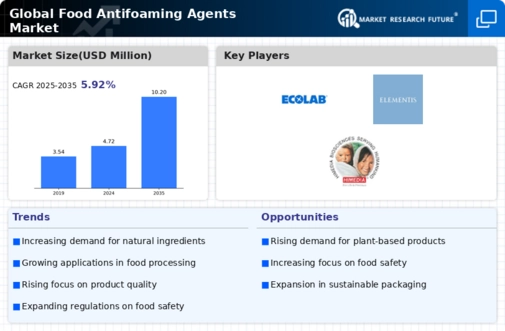Market Analysis
In-depth Analysis of Food Antifoaming Agents Market Industry Landscape
The market dynamics of food antifoaming agents are experiencing significant shifts influenced by a combination of factors that highlight the importance of efficient food processing, increased demand for processed foods, and advancements in food technology. Food antifoaming agents, also known as defoamers, play a crucial role in preventing or reducing foam formation during various food processing and manufacturing operations. One key driver of the market is the rising demand for processed and convenience foods across the globe. As the food industry continues to expand, the need for effective antifoaming agents grows, particularly in processes such as frying, baking, brewing, and dairy production, where foam can interfere with efficiency and product quality.
The food and beverage industry plays a central role in shaping the market dynamics of food antifoaming agents. With consumers seeking a wide variety of processed and packaged foods, manufacturers are increasingly relying on efficient production processes. Food antifoaming agents address challenges related to foam formation during the processing of various food products, ensuring smoother operations and higher production yields. This trend is driven by the need for cost-effective and reliable solutions to enhance production efficiency while maintaining the desired quality attributes of processed foods.
The emphasis on sustainability and clean-label ingredients is influencing the market dynamics of food antifoaming agents. Consumers are becoming more conscious of the ingredients used in their food, leading manufacturers to seek antifoaming agents that align with clean-label and environmentally friendly criteria. The market dynamics reflect an increased interest in natural and plant-derived antifoaming agents as alternatives to synthetic counterparts, responding to the growing consumer preference for sustainable and transparent food ingredients.
Technological advancements in food processing contribute to the evolving market dynamics of food antifoaming agents. As processing techniques become more sophisticated and the scale of production increases, the challenges related to foam formation become more complex. Innovations in antifoaming agent formulations and delivery systems address these challenges, promoting greater efficacy and adaptability to diverse food processing conditions. These advancements enhance the overall performance of food antifoaming agents, influencing market dynamics by providing solutions that meet the evolving needs of the food industry.
Global trade and international market dynamics also impact the food antifoaming agents market, as the sourcing and availability of raw materials from different regions influence pricing and supply chains. Regulatory considerations, quality standards, and variations in food processing practices contribute to the overall market dynamics, necessitating industry stakeholders to navigate and adapt to changing global conditions.
Challenges within the market dynamics of food antifoaming agents include regulatory scrutiny, especially concerning the use of certain chemical additives, and the need for continuous innovation to meet the diverse requirements of different food processing applications. The industry focuses on research and development efforts, collaborations with regulatory bodies, and the development of multifunctional antifoaming solutions to address these challenges.






Leave a Comment